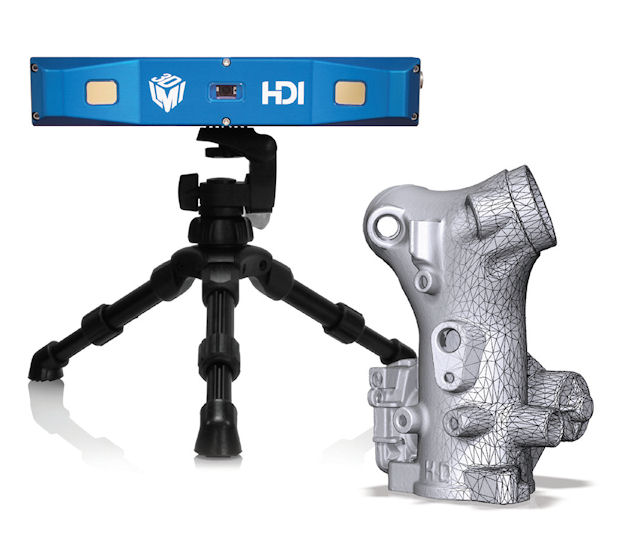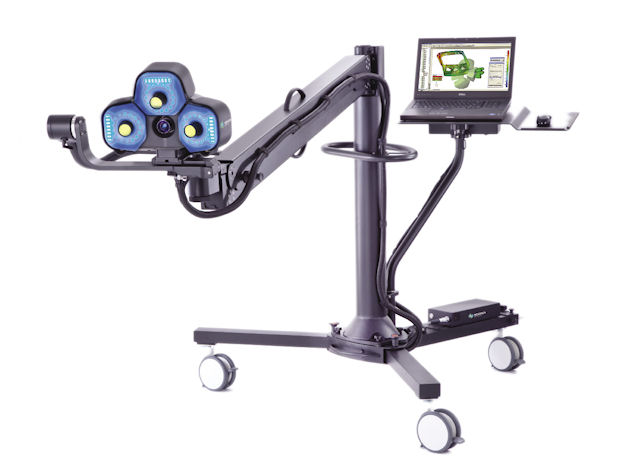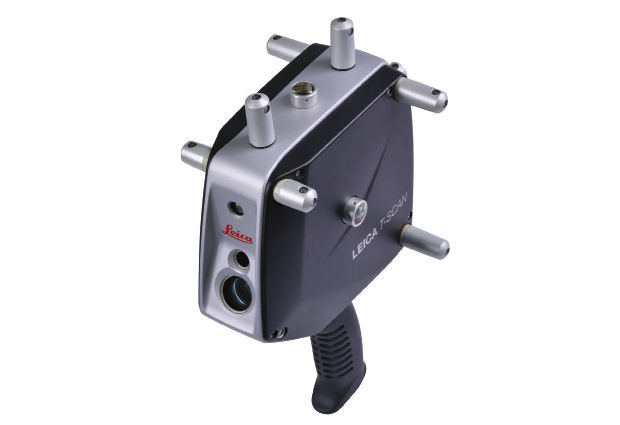Ease of Use Drives 3D Scanner Adoption in Engineering

LMI Technologies’HDI 120 uses blue LED projection technology to capture 3D scans for reverse engineering, inspection measurement, and visualization applications. It is dust-proof and water resistant for harsh environment operation.
Latest News
August 1, 2014
 LMI Technologies’HDI 120 uses blue LED projection technology to capture 3D scans for reverse engineering, inspection measurement, and visualization applications. It is dust-proof and water resistant for harsh environment operation.
LMI Technologies’HDI 120 uses blue LED projection technology to capture 3D scans for reverse engineering, inspection measurement, and visualization applications. It is dust-proof and water resistant for harsh environment operation.Data from Research and Markets published last year put the 3D scanning market at roughly $2.06 billion, and set to double by 2018 with a compound annual growth rate (CAGR) of 14.6%. Much of that is being driven by medical applications and dentistry, but prototyping, reverse engineering, quality control and other applications are also expanding.
That growth has been driven in large part by the steady increase in speed and accuracy of the scanners themselves, along with falling prices. The scanners are also smaller, easier to use, and can provide an increasingly valuable service for companies that need fast, accurate measurements, or that want to quickly generate 3D models. There are now hand-held, industrial-grade scanners that can be had for less than $20,000—providing a viable alternative for users who don’t need the extremely high level of resolution and accuracy provided by large, more expensive units.
“When scanners first emerged on the market, they weren’t widely accepted because people didn’t trust that they could be accurate,”says Burt Mason, regional sales manager at Hexagon Metrology. “Now they’ve proven their worth. You give up a little bit of accuracy compared to a hard probing system, but the speed, the amount of data you can capture and the color mapping you can get on the inspection side will overcome that small inaccuracy.”
 The Hexagon Metrology WLS qFLASH is a stereo vision system with low sensitivity to machinery vibration, industrial light, and temperature changes, making it suitable for capturing 3D measurements in shop floor environments.
The Hexagon Metrology WLS qFLASH is a stereo vision system with low sensitivity to machinery vibration, industrial light, and temperature changes, making it suitable for capturing 3D measurements in shop floor environments.The growth in 3D scanning has also been affected by the introduction of lower cost scanners in the sub-$5,000 range (in some cases, sub-$1,000). Most of these scanners are targeted at consumers, who use them in conjunction with 3D printing applications. That’s the case with 3D Systems’Sense scanner, MakerBot’s Digitizer Desktop unit, the Kickstarter-funded Fuel3D scanner, and similar devices.
“There are a lot of people interested in 3D scanners that are not concerned about accuracy, because you can do so much with low-accuracy 3D scanners,”says Thomas Tong, global sales manager for high-definition imaging (HDI) products at LMI Technologies. “Not everybody needs to capture the last micron of accuracy all the time. With the emergence of the consumer 3D printer, the consumer market has really elevated the status of 3D scanning.”
Although the scanners are less accurate than their industrial cousins, they are popular with home users, small businesses and hobbyists. However, in the bulk of professional applications, consumer-grade scanners do not provide the accuracy or resolution required for most design and production applications. These scanners can create point clouds, but they aren’t accurate enough for inspection applications—and most of the devices aren’t robust or rugged enough for the shop floor.
For companies or designers drawn to the technology by these consumer models, investigating professional-grade equipment can lead to a fair amount of sticker shock. “When we’re talking to customers, we have to explain the differences to our clients,”says Evgeny Lykhin, vice president of product management at Artec Group. “You have to know what applications the consumer scanners are built for, and what the industrial equipment is built for. We’ve had to conduct training with our distributors to discuss these issues with customers.”
 The Hexagon Metrology T-Scan 5 is targeted at non-contact laser scanning for CAD-to-part inspections and reverse engineering applications.
The Hexagon Metrology T-Scan 5 is targeted at non-contact laser scanning for CAD-to-part inspections and reverse engineering applications.In addition to providing greater accuracy and resolution, higher-end scanners can monitor environmental conditions that affect measurement accuracy like temperature, air pressure and humidity, along with desk vibration or movement. “Professional scanners outperform low-cost laser scanners in accuracy, stability, resolution, software capabilities, ease of use, and overall scan time from start to finish,” says Gleb Gusev, CTO at Artec Group.
“Professional grade scanners provide more dependability and repeatability,”Tong adds. “They also provide a workflow from beginning to end. If you have a reverse engineering application, these scanners provide a complete workflow to get you from the original part to a digital model, at a relatively quick pace. The consumer models can get you a 3D model, but you can’t depend on that data because the accuracy is so low.”
Ease of Use
While technical specifications are still important to companies evaluating new scanners, ease of use has become increasingly important as the scanning function moves from trained technicians and specialists to less-experienced users within an organization.
“Users have moved beyond price, accuracy and speed,”Tong says. “They are more interested in having a complete feature set or performance characteristics. They’re looking for mobility and ease of use, and whether you can connect different or multiple scanners to the solution.”Scanner manufacturers have made it easier and faster to configure and set up the scanners so that users can quickly start scanning objects with minimal training and start-up time. New scanner acquisition software is handling pre-processing tasks to speed delivery to CAD systems via features like built-in data editing, alignment and merging capabilities.
Wider integration with design and engineering software solutions is another important feature. Artec, for example, is releasing a software development kit (SDK) this year that provides integrated support of the company’s scanners for software developers. “What end users are looking for is an integrated experience, and a secure package where they can do all of their work,”Lykhin says.
Scanner Selection Criteria
When it comes to actually selecting a 3D scanner, knowing your application is critical. It seems obvious, but many companies approach what can be a very expensive purchase without clearly defining what they want to scan, what they want to accomplish with the data, and where the scanning will take place.
Outlining the application will determine the size of the equipment, the resolution and accuracy, and the level of ruggedization the equipment requires. “You have to know what you are trying to accomplish, otherwise you wind up buying a scanner that turns into a paperweight,”Tong says. “There’s no point in buying a $200,000 industrial scanner if you don’t need that accuracy or those performance characteristics. But it’s also a waste of time to spend $10,000 on a product that will not do what you need it to do.”
Application requirements will help guide the purchase decision based on technical specifications that include:
Set-up time: How long will the scanner take to warm up, mount, position and calibrate? Part preparation will also affect set-up, because some parts may require a coating, special lighting conditions, or the application of targets. Some newer units require very little warm-up time, which means scanning will occur faster.
Versatility: Not every scanner can be used to scan or measure every object. Determine whether the scanner can handle the range of parts you need to scan.
“When people buy a scanner, they assume they can scan anything, and that’s a common misconception,” Tong says. “Most scanners are narrowly defined devices, so if you need to scan coins, you will need a different piece of equipment than if you want to scan a car.”
Also, consider whether you will need hard probing capabilities, or other measurement tools to work with the scanner. “The scanner is not a silver bullet solution,”Tong says. “Most people looking for scanners have a measurement task or problem they want to solve, and they think a scanner can do everything for them. You have to understand that a scanner doesn’t replace calipers or other tools. It’s just another tool in the toolbox.”
User requirements: Who will do the actual scanning? If a designer or non-specialist will actually use the scanner, then ease-of-use, versatility and set-up time considerations will be even more important.
Accuracy: This is the degree to which the scanned data matches the physical object, and tolerances will vary based on the application. For critical design features in engineering applications, that accuracy may need to be in the range of 0.001 to 0.010 in. However, specifying inappropriately tight design tolerances can drive up cost.
“The most demanding industrial customers are in manufacturing,”Lykhin says. “They need the highest resolution and precision possible to make a comparison of the real object vs. the modeled one.”
“You really have to look at how the spec is developed, because specifications for laser scanners are all over the map,”says Hexagon Metrology’s Mason. “If you see the scanner listed at 30 microns, what does that mean? We test our systems with the laser scanner attached to the portable arm, and certify the entire system. Some companies give you just the accuracy of the scanner by itself.”
Resolution: Resolution refers to the spacing between the sampled points, and the required resolution will depend on the size of the smallest features that have to be scanned. Again, the application will determine how fine a resolution is required: Package design, for example, can have a coarser resolution than reverse engineering or digital archiving for remanufacture. Ultra-fine point resolutions can swell the size of the point cloud file, so define tolerances accordingly.
Scanner performance will also change with use. “The claimed precision of a scanner degrades with time because of temperature fluctuations and other factors,”Lykhin says. “The stated precision and resolution are typically determined with factory calibration. What customers should look into is the ability to recalibrate the scanner later without sending it back to the manufacturer.”
Scanner size and range: If you have to scan large objects or parts in service, the size and weight of the scanner (and its ability to be used in a mobile scenario) will be important. The range of the scanner (field of view and depth of field) will also affect scanning procedures. If the object exceeds those ranges, then stationary scanners will require multiple scans. The scanner’s coverage will also affect its ability to scan line of sight constraints like holes, undercuts, and channels.
Once you have a scanner in mind, test it on the largest part you plan to scan to verify its accuracy at different distances, and see how it performs with variable materials like paint, chrome, or light-absorbing surfaces.
“Don’t get overwhelmed by just having the ability to scan,”Mason says. “It’s easy to be impressed by the amount of data you can get, and overlook some of the realities of your environment and how they will affect the scanning performance.”
Brian Albright is a freelance journalist based in Columbus, OH. He is the former managing editor of Frontline Solutions magazine, and has been writing about technology topics since the mid-1990s. Send e-mail about this article to [email protected].
More Info
Subscribe to our FREE magazine, FREE email newsletters or both!
Latest News
About the Author
Brian Albright is the editorial director of Digital Engineering. Contact him at [email protected].
Follow DE





